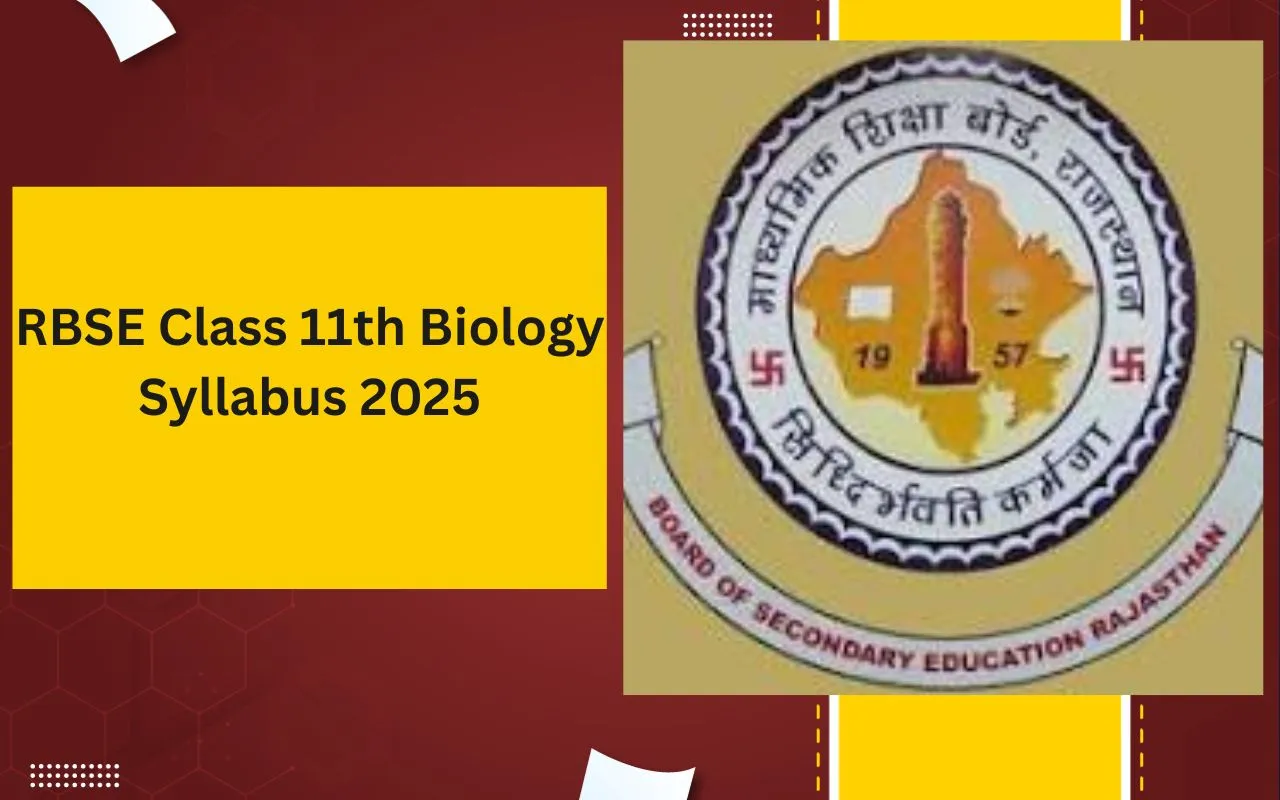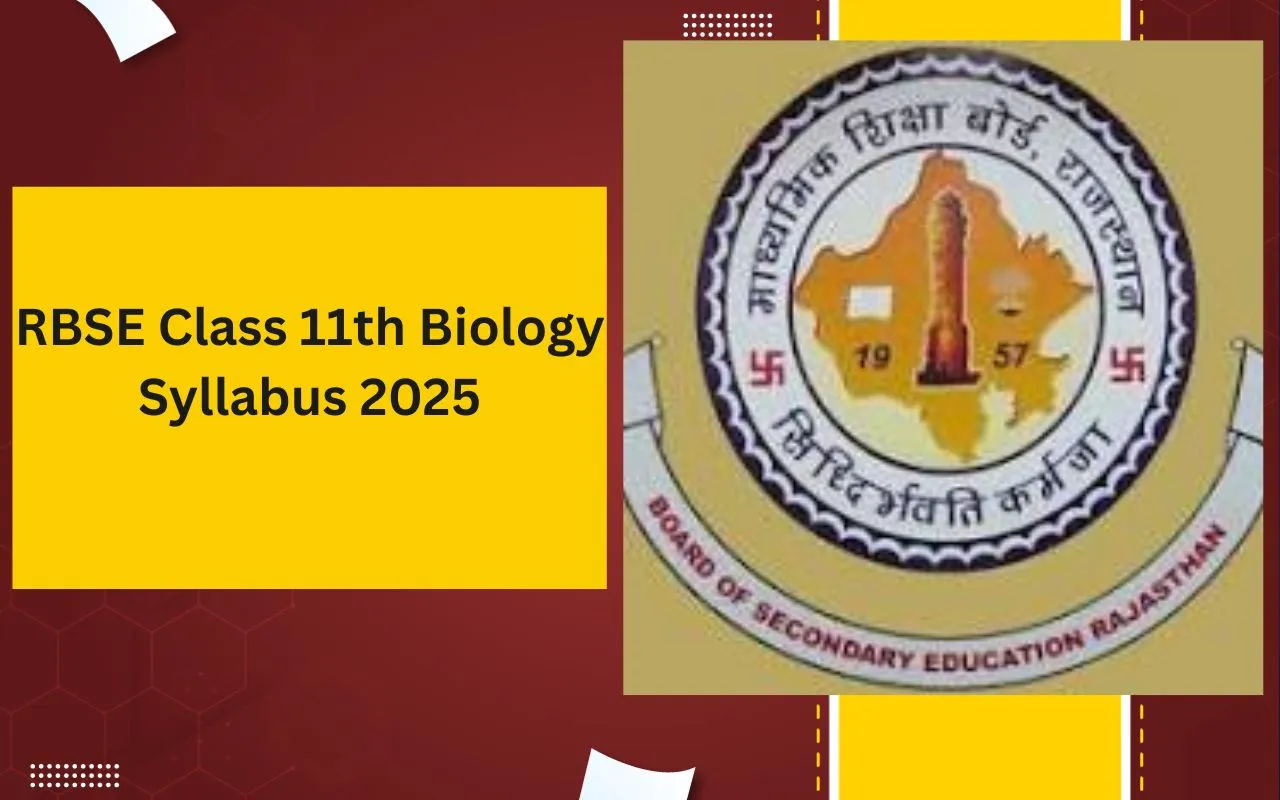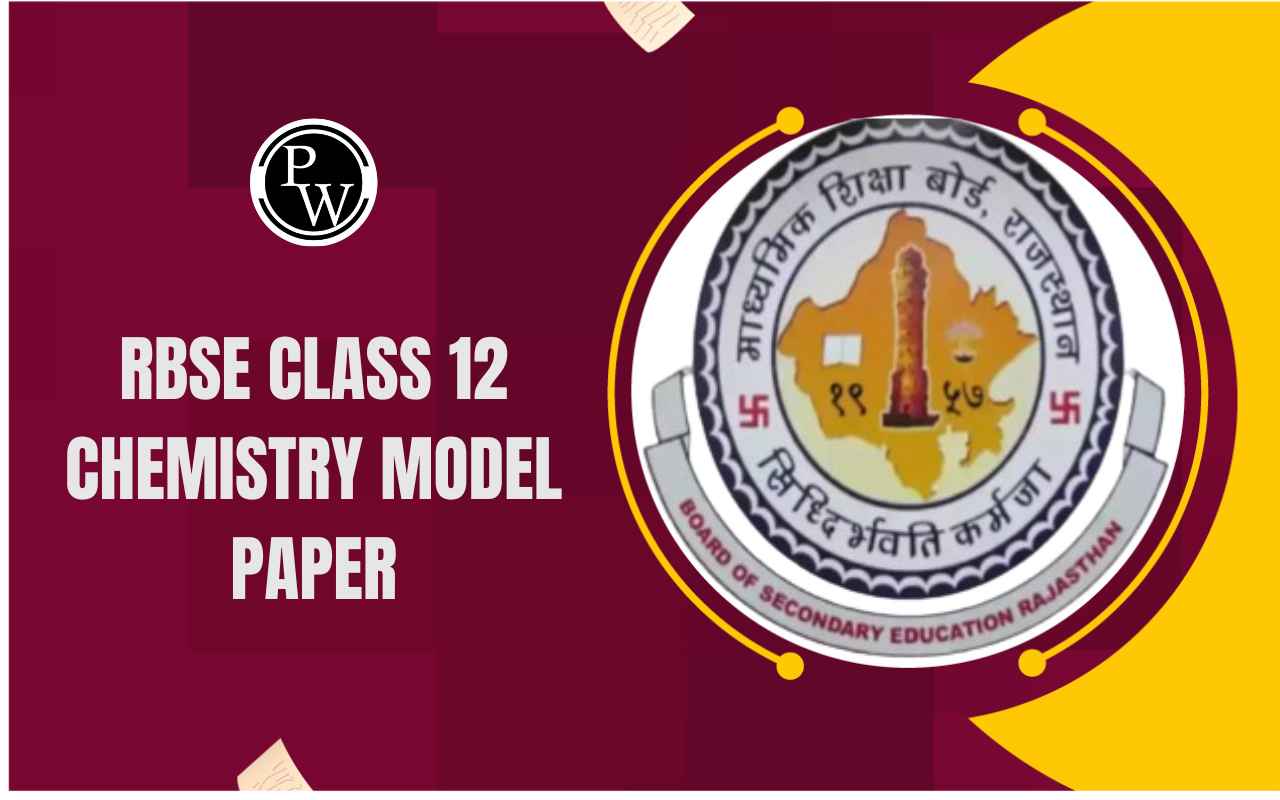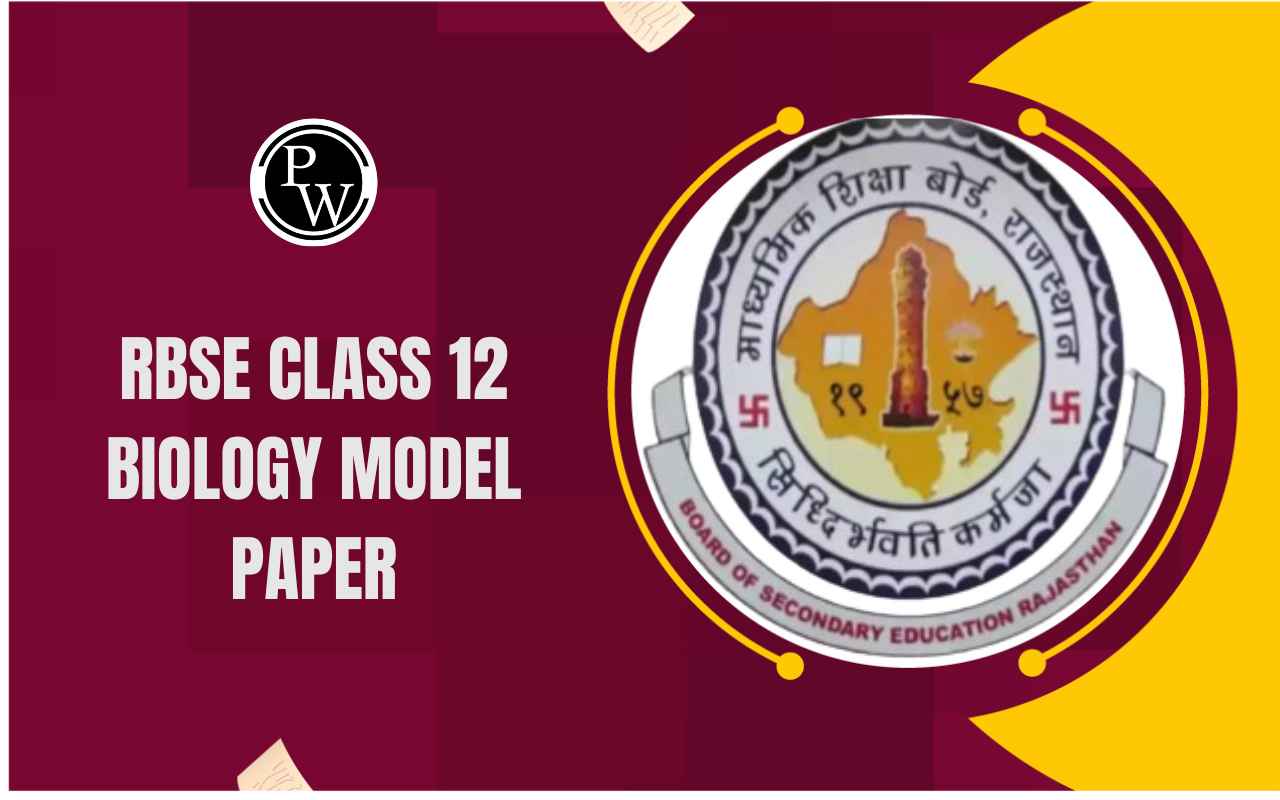

RBSE Class 11 Biology Syllabus 2025 has been released by the Rajasthan Board of Secondary Education (RBSE). The syllabus follows a structured and detailed approach, focusing on developing students’ understanding of living organisms, their structure, functions, and interactions with the environment.
It also emphasizes practical knowledge through experiments and observations. This syllabus not only helps students perform well in their Class 11 exams but also builds a solid base for the Class 12 board exams and various competitive medical entrance exams.
Students will learn theoretical concepts along with practical skills such as studying plant and animal tissues, photosynthesis, respiration, and biological processes, helping them apply knowledge confidently both in academics and daily life.
Also Read : RBSE 12th Toppers List 2025
RBSE Board Class 11 Biology Syllabus 2025 Overview
RBSE Board Class 11 Biology Syllabus 2025 carries a total weightage of 100 marks, and students are required to complete the written examination within 3 hours. The syllabus is carefully designed to provide students with a comprehensive understanding of fundamental biological concepts, along with practical knowledge.
|
RBSE Board Class 11 Biology Syllabus 2025 Overview |
|
|
Aspect |
Details |
|
Education Board |
Rajasthan Board of Secondary Education (RBSE) |
|
Class |
11th |
|
Subject |
Biology |
|
Academic Year |
2025-26 |
|
Total Marks |
100 (Theory + Practical) |
|
Medium |
English / Hindi |
RBSE Class 11 Biology Course Structure 2025
RBSE Class 11 Biology syllabus for 2025 covers essential topics to build a strong foundation in biological concepts. The syllabus is divided into units and chapters for easy understanding and systematic learning.
|
RBSE Class 11 Biology Course Structure 2025 |
||
|
Unit |
Chapter No. & Title |
Topics Covered |
|
Unit 1: Diversity in the Living World |
Chapter 1: The Living World |
1.1 Diversity in the living world 1.2 Taxonomic Hierarchy |
|
Chapter 2: Biological Classification |
2.1 Kingdom Monera 2.2 Kingdom Protista 2.3 Kingdom Fungi 2.4 Kingdom Plantae 2.5 Kingdom Animalia 2.6 Viruses, Viroids & Lichens |
|
|
Chapter 3: Plant Kingdom |
3.1 Algae 3.2 Bryophytes 3.3 Pteridophytes 3.4 Gymnosperms |
|
|
Unit 2: Structural Organization in Plants & Animals |
Chapter 5: Morphology of Flowering Plants |
5.1 The Root 5.2 The Stem 5.3 The Leaf 5.4 The Inflorescence 5.5 The Flower 5.6 The Fruit 5.7 The Seed 5.8 Semi-technical description of a typical flowering plant 5.9 Description of a family – (Solanaceae) |
|
Chapter 6: Anatomy of Flowering Plants |
6.1 The Tissue System 6.2 Anatomy of Dicotyledonous & Monocotyledonous Plants |
|
|
Chapter 7: Structural Organization in Animals |
7.1 Organ & Organ System 7.2 Frogs |
|
|
Unit 3: Cell Structure & Functions |
Chapter 8: Cell: The Unit of Life |
8.1 What is a cell? 8.2 Cell theory 8.3 An overview of cell 8.4 Prokaryotic cells 8.5 Eukaryotic cells |
|
Chapter 9: Biomolecules |
9.1 How to analyse chemical composition 9.2 Primary & secondary metabolites 9.3 Bio-macro-molecules 9.4 Proteins 9.5 Polysaccharides 9.6 Nucleic Acids 9.7 Structures of proteins 9.8 Enzymes |
|
|
Chapter 10: Cell Cycle and Cell Division |
10.1 Cell cycle 10.2 M-phase 10.3 Significance of mitosis 10.4 Meiosis 10.5 Significance of meiosis |
|
|
Unit 4: Photosynthesis and Respiration |
Chapter 11: Photosynthesis in Higher Plants |
11.1 What do we know? 11.2 Early experiments 11.3 Where does photosynthesis take place? 11.4 Pigments involved 11.5 Light reaction 11.6 Electron transport 11.7 Use of ATP and NADPH 11.8 The C4 pathway 11.9 Photorespiration 11.10 Factors affecting photosynthesis |
|
Chapter 12: Respiration in Plants |
12.1 Do plants breathe? 12.2 Glycolysis 12.3 Fermentation 12.4 Aerobic respiration 12.5 Respiratory balance sheet 12.6 Amphibolic pathway 12.7 Respiratory quotient |
|
|
Chapter 13: Plant Growth and Development |
13.1 Growth 13.2 Differentiation, Dedifferentiation and Redifferentiation 13.3 Development 13.4 Plant growth regulators |
|
|
Unit 5: Human Physiology |
Chapter 14: Breathing and Exchange of Gases |
14.1 Respiratory organs 14.2 Mechanism of breathing 14.3 Exchange of gases 14.4 Transport of gases 14.5 Regulation of respiration 14.6 Disorders of respiratory system |
|
Chapter 15: Body Fluids and Circulation |
15.1 Blood 15.2 Lymph (Tissue fluid) 15.3 Circulatory pathways 15.4 Double circulation 15.5 Regulation of cardiac activity 15.6 Disorders of circulatory system |
|
|
Chapter 16: Excretory Products and Their Elimination |
16.1 Human excretory system 16.2 Urine formation 16.3 Function of tubules 16.4 Concentration of filtrate 16.5 Regulation of kidney function 16.6 Micturition 16.7 Role of other organs in excretion 16.8 Disorders of excretory system |
|
|
Chapter 18: Neural Control and Coordination |
18.1 Neural system 18.2 Human neural system 18.3 Neuron as structural and functional unit 18.4 Central neural system |
|
|
Chapter 19: Chemical Coordination and Integration |
19.1 Endocrine glands and hormones 19.2 Human endocrine system 19.3 Hormones of heart, kidney, and gastrointestinal tract 19.4 Mechanism of hormone action |
|
Also Read : RBSE Class 12th Preparation Tips
RBSE Class 11 Biology Practical Syllabus 2025
RBSE Class 11 Biology practical syllabus is created to provide students with hands-on experience in key biological concepts and processes. These experiments and activities help reinforce theoretical knowledge through observation, analysis, and practical application.
|
RBSE Class 11 Biology Practical Syllabus 2025 |
||
|
Practical No. |
Experiment / Activity |
Details |
|
1 |
Study and describe common flowering plants |
Study locally available plants from families like Solanaceae, Fabaceae, and Liliaceae. |
|
2 |
Preparation and study of T.S. of dicot and monocot roots and stems (primary) |
Observe and draw transverse sections of dicot and monocot roots and stems. |
|
3 |
Study of stomata distribution |
Examine stomata on upper and lower leaf surfaces and note differences. |
|
4 |
Study of osmosis using potato osmometer |
Demonstrate osmosis in potato cells using different solutions. |
|
5 |
Separation of plant pigments |
Use paper chromatography to separate and identify plant pigments. |
|
6 |
Study of plasmolysis in epidermal peels |
Observe plasmolysis in Rhoeo leaf epidermal peels under hypertonic solutions. |
|
7 |
Study of respiration rate |
Measure respiration rate in flower buds and germinating seeds. |
|
8 |
Comparative study of transpiration rates |
Compare transpiration from upper and lower surfaces of leaves. |
|
9 |
Effect of salivary amylase on starch |
Study the enzymatic breakdown of starch by saliva. |
|
10 |
Tests for biomolecules |
Perform tests to detect sugar, starch, protein, and fats in plant and animal samples. |
|
11 |
Test for sugar and albumin in urine |
Conduct qualitative tests to detect glucose and albumin in urine samples. |
|
12 |
Test for urea and bile salts in urine |
Detect presence of urea and bile salts in urine using appropriate reagents. |
|
13 |
Study types of roots, stems, and leaves |
Identify and classify tap/adventitious roots, herbaceous/woody stems, and leaf types. |
Spotting and Observational Activities
Spotting and observational activities in RBSE Class 11 Biology practical syllabus help students develop skills in identifying and understanding various biological specimens and phenomena. These activities encourage detailed observation, analysis, and explanation of living organisms and their structures.
|
RBSE Class 11 Biology Practical Syllabus 2025 |
||
|
Practical No. |
Activity |
Details |
|
1 |
Study parts of a compound microscope |
Identify and understand the functions of microscope parts. |
|
2 |
Study and identify specimens |
Identify bacteria, algae, fungi, bryophytes, pteridophytes, gymnosperms, angiosperms, lichens, etc. |
|
3 |
Study and identify animals |
Identify and classify protozoa, worms, insects, fishes, amphibians, reptiles, birds, and mammals. |
|
4 |
Study plant and animal tissues |
Observe and identify plant tissues (parenchyma, collenchyma, sclerenchyma, xylem, phloem) and animal tissues (epithelium, muscle fibers, blood). |
|
5 |
Study mitosis in onion root tips and grasshopper |
Observe different stages of mitosis using permanent slides. |
|
6 |
Study modifications in roots, stems, and leaves |
Examine various adaptations in plant organs. |
|
7 |
Study different types of inflorescences |
Identify racemose, cymose, and other inflorescence types. |
|
8 |
Study imbibition |
Observe seed/raisin imbibition to understand water absorption. |
|
9 |
Observe and comment on experimental setups |
Study experiments on anaerobic respiration, phototropism, apical bud removal, and transpiration suction. |
|
10 |
Study human skeleton and types of joints |
Identify major bones and classify joints based on movement. |
|
11 |
Study frog morphology |
Study external and internal features of frogs using models or preserved specimens. |
RBSE Class 11th Biology Syllabus 2025 PDF Download
Students can download the official RBSE Class 11th Biology Syllabus 2025 PDF from the Rajasthan Board of Secondary Education website or authorized portals. The syllabus is designed to cover all essential topics in biology, including diversity of living organisms, cell structure and function, plant and animal physiology, and human biology. This comprehensive syllabus helps students build a strong foundation for higher studies and competitive exams. Regularly following the syllabus will ensure effective preparation, reduce exam stress, and enhance overall academic performance in Biology.
RBSE Class 11th Biology Syllabus 2025
Study without using the internet
How to Prepare for RBSE Class 11th Biology Exam 2025?
Preparing for the RBSE Class 11th Biology exam requires a focused approach to understanding concepts, practical knowledge, and regular revision. Here are some effective tips to help you prepare well:
-
Familiarize yourself with the entire RBSE Class 11 Biology syllabus, including units like Diversity of Living Organisms, Cell Structure and Function, Plant and Animal Physiology, and Human Biology. Knowing the syllabus helps prioritize important topics.
-
Biology involves understanding processes and mechanisms. Pay special attention to topics like cell division, photosynthesis, respiration, and human physiology. Use diagrams and flowcharts to visualize concepts.
-
Maintain concise notes for each chapter highlighting key points, definitions, and important diagrams. Regular revision will strengthen your memory and help in quick recall during exams.
-
Many questions require diagram drawing and labeling. Practice sketching neat and accurate diagrams of cells, plant and animal tissues, human organs, and other biological structures.
-
Practice past question papers and sample papers to understand exam patterns and question types. This also improves your time management skills during the exam.
-
Follow your prescribed textbooks carefully, as most exam questions are based on these. Supplement your study with reference books or online resources if needed.
RBSE Class 11th Biology Syllabus 2025 FAQs
Has the RBSE Class 11th Biology Syllabus 2025 been released?
What are the main units covered in the RBSE Class 11 Biology Syllabus 2025?
Is the RBSE Class 11 Biology syllabus available in both English and Hindi?
Does the syllabus include practical topics for Biology?













